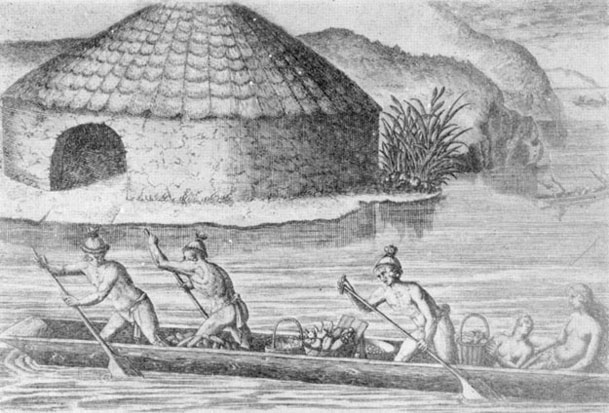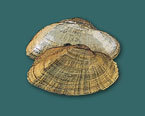
The first connection between mussels and man in North America
was undoubtedly culinary. Prehistoric people ate mussels. Lots of them.
We know this from the massive piles of shells they left in their wake.
The archaeology of Eastern North America seemingly goes from one mussel
bed to the next. Waterways of the Southeast are littered with shells. They
are a formidable statement from the prehistoric past. But what can they
tell us?

Storehouse of the Timucua indians. (After Le Moyne) - Bureau of American Ethnology
Due to large numbers of mussel shells found at archaeological sites, we know they were utilized. Whether they were tasty or not is another matter. To our modern day palates it’s universally assumed that while salt water mussels are highly prized, freshwater mussels are not something particularly appetizing. Historian John Lawson wrote in 1860 that “mussels are eaten by the Indians, after five or six hours boiling to make them tender, and then are good for nothing.” Perhaps Mr. Lawson was not very hungry. Freshwater mussels are edible, and they can provide valuable protein. Two scientists from the University of Illinois attempted to clarify the nutritional value of freshwater mussels. They collected 792 mussels, representing 39 species, and analyzed the “meat’ for protein and caloric content. Their conclusions, the average prehistoric family would have needed to collect an astonishing 300 to 450 muckets per day in order to survive. A band of 25 individuals, typical for the Archaic Period would require 57,000 to 67,000 muckets to live for a month. The conclusion of the authors of this study was that mussels, even though the evidence of their shells can be seen in great abundance, were not used as a primary food source but rather as adjuncts to other more primary sources. Prehistoric appetizers perhaps? Whatever the interpretation, mussels had to be an important resource for the early inhabitants of North America.

Sorting Table
It’s interesting to note that the archeological studies involving North America's mussel fauna work both ways. The shell middens of the Southeast not only tell us about the people that lived there, they can tell us about how aquatic environment changed over time as well. In another interesting study, archeologists have determined that for at least one group of mussels, the Epioblasma, the relationship between mussels and men often turns out bad for the mussels. Following the population trends determined by study of the shell midens, the scientists found that the numbers of epioblasma were relatively constant for 5000 years. Then, just a thousand years ago, there was a precipitous decline. The authors of the study noted that this was the same period as the rise of corn and bean cultivation in the Southeast. Did sedimentation and siltation destroy this mussel resource a thousand years ago? Was the development of agriculture the first bell toll in a continuing dirge as our mussel populations decline?
The relationship between mussels and men has always been complicated.





